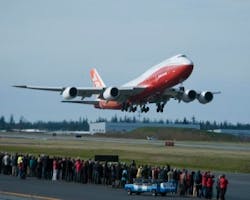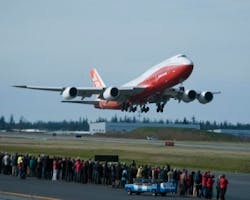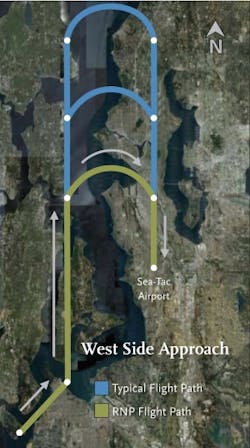High-end RNP: flying through a soda straw
High-end required navigation performance (RNP) is coming into its own. Many of today's commercial and business jets are equipped to fly these ultra-narrow flight paths and many operators are jumping on board. High-end RNP -- known as RNP SAAAR (special aircraft and aircrew authorization required) or RNP AR (authorization required) -- is popular with the airlines.
In addition to pioneers like Alaska Airlines and Canada's WestJet, Delta Air Lines is a major user, and Southwest began RNP operations this year. Other SAAAR operators include Qantas, American, Continental, Air New Zealand, and JetBlue. RNP SAAAR approach procedures are particularly popular. The Federal Aviation Administration (FAA) points to 238 RNP SAAAR approaches in the U.S., as of Dec. 16, 2010.
The approaches feature path widths as low as 0.2 nautical miles -- 2x the lowest RNP 0.1 value -- with vertical guidance. To fly RNP 0.1 procedures, the aircraft must be equipped, the crew trained, and the carrier approved to keep to the desired track within 0.1 nautical miles of the centerline 95 percent of the time. RNP procedures require not only the avionics to stay on the desired flight path, but onboard monitoring and alerting if actual navigation performance (ANP) should exceed RNP.
Alaska Airlines started RNP work with its approach to Juneau (JNU) via the Gastineau Channel -- RNP 0.15 at its lowest value. The driver was increasing access to an airport surrounded by terrain and plagued by poor weather conditions. Before the
"We were trying to reduce the number of traditional non-precision approaches we were exposed to, and RNP fit that bill perfectly," says Darcy Granley, director of flight technical operations for WestJet. NPAs in mountainous terrain can require maneuvers such as circling (within a valley) to land. High-end RNP design criteria involve narrow, linear, lateral protection areas, and FMS-based flight path guidance. This, plus the ability to add curved segments -- known as radius-to-fix, or RF legs -- enables an aircraft to snake around obstacles rather than overfly them. Minimums can be much lower than those for traditional NPAs and flight paths can be safely shortened, reducing fuel burn. WestJet can save about 80 pounds of fuel per arrival for straight-in RNP vs. conventional "dive-and-drive" approaches, where the aircraft constantly powers up and powers down as it comes down to the runway. On some approaches the airline can save almost 50 track miles.RNP allows the Canadian carrier to lift more weight into terrain-rich environments like Kelowna, British Columbia, Granley says. This RNP 0.1 approach involves a number of RF turns through the valley to avoid terrain. RNP also allows WestJet to build
Alaska Airlines calculates RNP benefits in terms of approach and departure "saves," Dalton explains. A save is a flight that, without RNP and its lower minimums, would not have gotten into or out of an airport. In 2010 Alaska enjoyed more than 1,500 RNP saves, the vast majority of which were due to procedures the airline developed itself. Dalton says Alaska is the first airline to be 100 percent RNP-equipped. Alaska flew its first RNP procedure in revenue service in 1996, before there were procedure development criteria or third parties to help out. Today the carrier has the authority to conduct obstacle assessments and flight validation for its own procedures. The FAA participates in the flights, however, and Alaska submits its procedures to the agency for approval. Alaska flies proprietary procedures into 11 airports, Dalton says. The airline has 22 special approaches and 15 special departures. The remaining procedures are FAA public ones. Last year the airline flew nearly 12,000 RNP approaches and departures, and only 48 of the approaches used FAA-developed procedures. This month the carrier announced that it has developed new RNP approach procedures into Adak and Ketchikan, Alaska.



